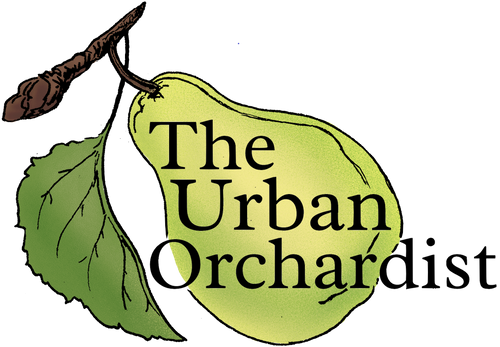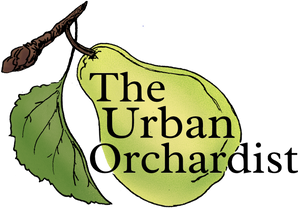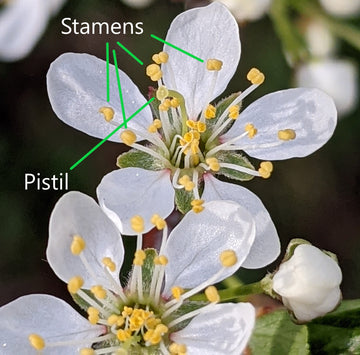Having a solid understanding of pollination is essential when purchasing fruit trees or establishing an orchard. As I've learned more about pollination I've realized how much my home food forest could have improved with the addition of the right plants. And I wonder how many situations of lacklustre fruit tree productivity could be remedied with a better understanding of pollination.
Like any plant (and any organism), one of a fruit tree’s main goals is to produce offspring. With few exceptions, flowering plants require pollination in order to make the fruit. Some plants are able to achieve pollination on their own (these are called self-pollinating, or self-fertile), while others require another plant of the same species to achieve pollination (these are called cross-pollinating, self-sterile, or self-incompatible).
Most fruit and nut trees are self-incompatible and require cross-pollination, meaning if you want fruit you have to plant more than one of the same species. Furthermore, they require pollination by a genetically-unique member of their species - two of the same variety don't work so well, because they are essentially clones of the same parent genetics. So two Honeycrisp apple trees are too genetically similar to pollinate each other, but a Honeycrisp can be pollinated by an Empire. In contrast, peach trees (and some other stone fruits), or gooseberries (and most berry bushes) are self-fertile – you can plant just one and get fruit.

(Figure 1. Plum flowers showing stamens (which release pollen) and pistils (which receive pollen and contain an ovule at their base that will make fruit if fertilized). Image source Matt Soltys.)
As with all rules, there are exceptions. There are a small handful of self-fertile apple, pear, and sweet cherry cultivars (good to seek out if you have a small space). That said, self-fertile fruit trees will generally produce better quality fruit with cross-pollination. So if you have a fruit tree that does make fruit on its own, it may be worth planting a second cultivar of the same species that is a known compatible pollenizer. You may find more fruit stays on the tree until harvest, or the fruit is larger, or has a better taste.
It’s also important to know that not all cultivars are compatible pollenizers for each other. For example, you can have two pear cultivars that are genetically unique enough to pollinate each other, but if they flower at different times (i.e. one flowers and sheds pollen before the other is receptive to pollen) then the insects that transfer pollen will not be able to perform cross-pollination.
Take pawpaws (Asimina triloba), for example. The reason for the self-incompatibility of pawpaws is that a pawpaw tree’s stigmas (the part at the end of the pistil, upon which pollen must land for pollination to occur) are receptive to pollen before its own pollen is shed (Losada et al. 2017). It can only be pollinated (and make fruit) if other pawpaws are around who are shedding pollen at the same time that its stigmas are receptive to pollen. And likewise, it can only pollinate other pawpaws who have stigmas receptive at the same that it is shedding pollen.

(Figure 2. Pawpaw (Asimina triloba) flowers. Note the different stages of pollen-shedding and stigma-receptivity exhibited between the flowers. Image source Borge 2020.)
Also, some cultivars have weaker or stronger pollenizing abilities than others, and some have sterile pollen, so even if they do flower simultaneously they don’t all pollinate each other. For example, I once bought two pear trees from a nursery, thinking I was being smart by buying two. A year later I learned that one of my varieties is unable to pollinate others due to having a triploid chromosome. So I have these two varieties – Luscious and Harrow Crisp – and Harrow Crisp can pollinate Luscious, but Luscious cannot pollinate Harrow Crisp. So if I want to eat from my Harrow Crisp pear tree, I need to find another pollen source. I could graft a compatible pollenizer on to Harrow Crisp, plant a third tree (or get my neighbours to plant pear trees), or collect pollen from another tree and hand-pollinate my Harrow Crisp (incidentally, this last method can be achieved by cutting a branch off a pear tree in advance of flowering, and putting it in a jar of water inside. The warm temperature will initiate flowering, and you can collect the pollen and store it in your fridge for later use.
This is all to say that when purchasing a fruit tree, you need to look into whether it is self-compatible or self-incompatible. If you do need to have two varieties of your desired fruit tree, you need to make sure they are compatible pollenizers for each other and they flower around the same time.
A couple resources:
UC Davis has a Fruit & Nut Research & Information Center with an excellent page on Flower Anatomy & Pollination that is a good place to learn more.
Orange Pippin Trees has a Pollination Checker that is a great resource for learning the pollination requirements for some species and cultivars. You can select from a list of cultivars and see their recommended pollenizers for cross-pollination.
References:
Borge, M.A. 2020. Benefits of Pawpaws. The Natural Web: Exploring Nature's Connections. https://the-natural-web.org/2015/09/21/benefits-of-pawpaws.
Losada, J.M., Hormaza, J.I., Lora, J. (2017). Pollen–pistil interaction in pawpaw (Asimina triloba), the northernmost species of the mainly tropical family Annonaceae. American Journal of Botany, 104(12), 1891–1903.


